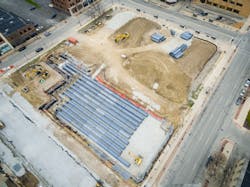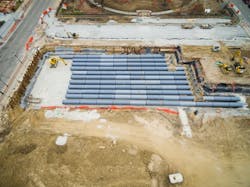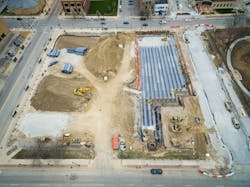Capital Improvements
About the author:
Steve Cooper is writer for SCA Communications. Cooper can be reached at [email protected].
As part of a downtown revitalization effort, Springfield, the capital of Illinois, is turning a two-block section of historic Jackson Street immediately adjacent to the governor’s mansion into a pedestrian-orientated corridor enhanced with spaces for hosting permanent and temporary outdoor events. Previously the site of deserted 100-year-old buildings, Jackson Street is one of the city’s original roads, dating back to the 1830s. Running underneath the street is a portion of the Town Branch combined sewer system, a brick-arch structure constructed in the late 1860s and relined in the early 1970s. As part of the master plan, the city decided that while the renewal of the area was underway, it would be a beneficial time to also address the frequent flooding in the area, which mostly was a result of the limited capacity of the combined sanitary and storm sewer system. Once the underground detention system was installed, the overflow from the Town Branch system during a heavy storm would fill a nearly 1/2-mile 5-ft-diameter pipe to be slowly discharged back into the combined sewer system.
Bicentennial Beautification
“Jackson Street is the city’s contribution to the Illinois Bicentennial, and is going to help beautify this stretch of downtown,” said Chris J. Stritzel, P.E., project engineer for Crawford, Murphy & Tilly Inc. (CMT). “We were engaged by Springfield Public Works at the request of the mayor to not only look at doing this underground detention system, but also the streetscape along Jackson Street between Fourth and Fifth [Streets].
“The local landscape architect, Massie Massie and Associates, was very instrumental in getting these projects going. As part of the plan Massie did for the corridor, the city considered how to start mitigating some of the flooding. It just so happens that this beautification project is right on top of the existing 100-plus-year-old brick arch Town Branch combined sewer. It has various shapes and sizes but we generically call it a 7-ft-by-6-ft brick arch sewer.”
The brick arch sewer runs diagonally under the governor’s mansion, the realtors block, Jackson Street and property north of Jackson Street that is slated for development, he added. The city purchased that block with multiuse development in mind. Because the opportunity presented itself, the city decided to start making a dent in the combined sewer capacity limitation in downtown Springfield.
“As such, a third of the block would be available for underground detention and the rest reserved for development, which was how we basically arrived at the size of the system,” Stritzel said. “While it will not solve the urban flooding problem in downtown Springfield, it’s one step in the right direction that will have to be combined with other future projects and endeavors. It’s just a fraction of what is needed to overcome 150 years of unrestricted development.“
An updated model of the watershed from CMT showed the new detention system design would reduce flooding during low-intensity storm events near the project area. There were some stumbling blocks, however.
“There are some railroad underpasses and other low-lying areas that are problem areas,” Stritzel said. “Since this is a combined sewer system, using a surface solution or an open-bottom chamber-type system were not options. Water had to be contained and be out of sight.”
Subterranean Solution
Stritzel and his team investigated and considered concrete, steel-reinforced polyethylene, fiberglass and polypropylene pipe. In addition to containment capacity, soil contamination was considered in the evaluation process. A geosynthetic liner sewn together with bentonite plugs would be used to provide protection from trace amounts of trichloroethylene and tetrachloroethylene located onsite. Encapsulating the entire excavation site would mitigate any future groundwater or soil migration of particles in and around the pipe.
“The block had contamination both in the soil and the groundwater. Very low traces of petroleum products and chemicals [were] left over from the site’s long history of factories, service stations and other businesses,” Stritzel said. “No one was comfortable with putting in pipe and leaving the contamination in the ground that could impact the joints or the pipe materials, degrading the structural integrity of the system over time, and removal costs of the contamination were prohibitive. We figured out we were looking at one product that made the most sense, financially and for the longevity of the system, which was the SaniTite HP polypropylene pipe, in combination with the geosynthetic liner.”
To reach the design storage capacity of 45,611 cu ft or 341,193 gal of water, the 11-ft-deep pit was excavated and 2,300 ft of the SaniTite HP pipe from Advanced Drainage Systems Inc. (ADS) was installed by Petersburg Plumbing and Excavating, a subsidiary of Henson Robinson Co. O’Shea Builders was the general contractor for the entire project; both companies are based in Springfield.
“We used a benching method because the pit was about 11 plus ft deep,” said Brian K. Vogt, president and project manager for Petersburg. “So instead of shoring, we used the natural benching process to slope the dirt and follow [Occupational Safety and Health Administration] regulations. Our initial focus was to get benching done, get it correct and have all the egress ladders in place. This project is a little different because it has a bentonite liner that we had to lay down on the bottom, up the sides and around the top to envelop the SaniTite pipe. First, we used a rock conveyor truck to put the sand over the liner. Then we conveyed out the rock bed and continued to lay in the SaniTite pipe and put the fittings together. We were digging and laying out the system at the same time. Once we got it all laid and buttoned together, we actually started conveying rock out between the pipe to the haunches to a foot above the entire system.”
An eight-man crew stretched the liner across the space, and then O’Shea backfilled the hole to the specified grade.
The 115 sections of 60-in.-diameter pipe were laid in 11 rows in the 275-by-91-ft pit. Ten 60-in. custom-made manifolds, each with a riser for clean-out access, connected the rows. An additional 200 ft of 24-in.-diameter pipe was used on the western side to connect each row of 60-in.-diameter pipe to produce a closed rectangular system and to relieve any air pockets or pressure that could form in the individual rows. Water enters and exits the system from a connection to the Town Branch sewer in the northwest corner.
According to ADS, SaniTite HP pipe stiffness and beam strength minimizes deflection for long-term performance. It also meets ASTM F2736 and ASTM F2764, and exceeds ASTM D3212 for water tightness with dual gaskets and a banded reinforced bell. The polypropylene from which the pipe is designed was made to last more than 100 years. The tight tolerance and double-gasketed connection providing protection to the surrounding soil and groundwater, especially during large rain events, also were important features of the project.
Instant Results
The pipe, fittings, tees and manifolds were manufactured and fabricated at the ADS plant in Mendota, Ill. The company has 60 plants and 30 distribution centers worldwide to provide quick, local delivery, a factor that was important on this project.
“We were on a deadline for this contract, so we were working 10-hour days to get it done on time,” Vogt said. “We started the project on the first of April and had a lot of rain. Our office coordinated with ADS and O’Shea to get it all delivered. It worked out great. We never were down waiting on pipe or fittings and got it done ahead of schedule. It was an excellent team effort.”
Testing verified the integrity of the joints and fittings, and also determined that the pipe can hold up to 10.8, or 15 psi if back-charging flow occurs during a temporary surge.
“It was very easy to move around,” Vogt said. “[The pipe] snaps together very nicely, and with a double gasket like that, provided confidence in having a good sealed joint. We were very happy with it.”
It rained the day after the pipe was backfilled to grade; the system’s first real test upon completion.
“We got tied into the Town Branch, sealed off, and then it rained pretty good,” Vogt said. “The Town Branch filled into the system just like it was supposed to.”
About the Author
Steve Cooper
Steve Cooper is a writer for SCA Communications. Cooper can be reached at [email protected].


